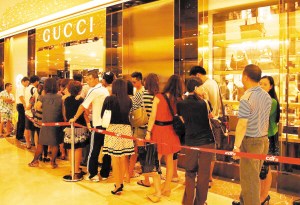
(Ecns.cn) – China is set to surpass Japan as the world's largest luxury market this year, according to industry watchers, making it a core target for global luxury brands.
With nearly 200 million consumers for luxury goods, the country is now seen as a source of hope for luxury items that have been weeded out of the European market, notes the state-run Oriental Outlook magazine.
Experts say this is because China is a very different kind of market: Chinese consumers scramble for luxury items under the Asian cultural influence of "face" (which has also contributed to the strong desire for brands in Japan). Moreover, those dwelling in China's second- and third-tier cities tend to be on a more blind pursuit for luxury products, making them an easier target even for outdated merchandise.
Rich and young
The mainstream Chinese consumer group for luxury goods accounts for about 16 percent of the total population, and will continue to grow by an expected 25 percent every year, according to the World Luxury Association (WLA), a nonprofit organization specializing in market research.
They mainly live in first- and second-tier cities and are divided into two categories – the rich and the young. Yet even the young consumers have very strong spending power, with monthly incomes falling between 20,000 yuan (US$3,174) and 50,000 yuan (US$7,935).
In China, those dedicated to the world of luxury brands are 10 to 20 years younger than the average age in developed nations, underpinned by the fact that the average age of a Chinese multimillionaire is only 39, according to the 2011 Hurun Wealth Report.
This differs greatly from Western countries, where the number of consumers for luxury goods only accounts for about 1 percent of the total population, and their ages are normally above 40.
Moreover, the WLA forecasts that those between 25 and 30 will become the bulk consumers for luxury goods in China in about five years.
Data show that those dominating the consumer group for luxury brands were aged 35 to 45 in 2007, 29 to 45 in 2009, and 22 to 45 in 2011, according to Oriental Outlook.
The lure of the lower-tier
In metropolises such as Beijing and Shanghai, office ladies carrying Louis Vuitton handbags can frequently be seen squeezing through crowds at bus stops and subway stations.
Labels such as Hermes, Chanel, Louis Vuitton and Prada satisfy the younger generation's need to prove their social status, a Chinese characteristic of luxury brand consumption.
In 2010, new consumers contributed about 67 percent of the growth in domestic luxury consumption in China, which indicated a declining spending power by existing consumers that year.
According to Ouyang Kun, chief of the WLA's China office, the rate of customer defections from the Louis Vuitton shop at Beijing's Shin Kong Palace is about 5 to 10 percent every year, but it is also a popular phenomenon across the country.
In many first-tier cities, sales of luxury brands at franchise houses have been declining by 5 to 10 percent every year, said Ouyang. To achieve profit growth, many luxury brands have extended their businesses to second- and third-tier cities.
In lower-tier locations, luxury items that were popular two years ago in Europe can still be sold, since few care about whether an item is a new release. In Europe, these items might have been pulled from shelves or gone on sale, but in second- and third-tier cities their value can be revived.
Opportunities and challenges
For international luxury brands in decline, it is good news that they are still sought after by an increasing number of consumers in China, creating opportunities to expand their businesses and develop new modes of marketing.
In second- and third-tier cities, large advertising posters for luxury brands are rarely seen, and local information on the latest arrivals is not prominently featured in fashion magazines. The most effective way is to let consumers show off their luxury items to their acquaintances in person, said Ouyang Kun.
Markets in first-tier cities such as Beijing and Shanghai are highly mature. But as more luxury retailers are distributed deeper into China, people will naturally become more familiar with the charm of luxury goods beyond the big cities.
In three to five years, a so-called "circle" will take shape in these lower-tier areas, and people may refer to luxury goods to judge social status, which is more about psychological need, added Ouyang.
Meanwhile, with the average age of luxury consumers falling in China, a new business model has emerged for luxury brands since 2010 – e-commerce.
The market is developing so rapidly that as of this month one can even buy a Mercedes-Benz smart car from online retailer Jingdong Mall (360buy.com).
However, as more marketing strategies come out, luxury brands are also facing different challenges. By expanding businesses both online and in real stores, they must find a balance between different sales channels. Otherwise, their profit growth targets may suffer.

Copyright ©1999-2011 Chinanews.com. All rights reserved.
Reproduction in whole or in part without permission is prohibited.